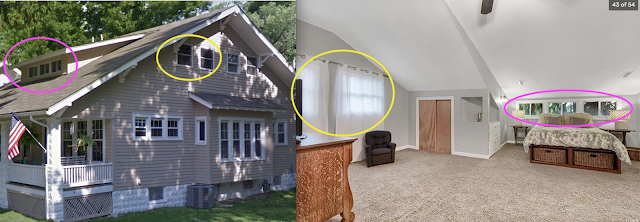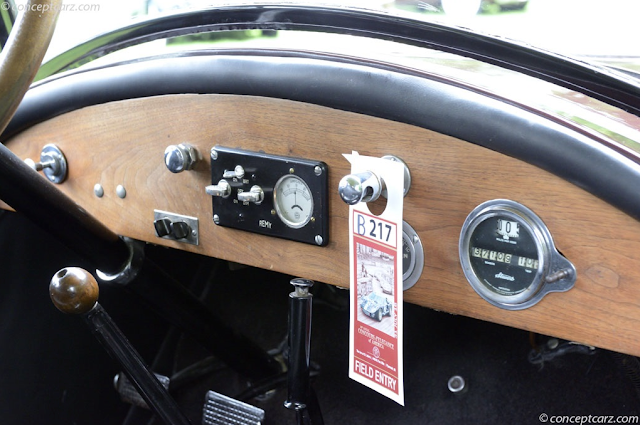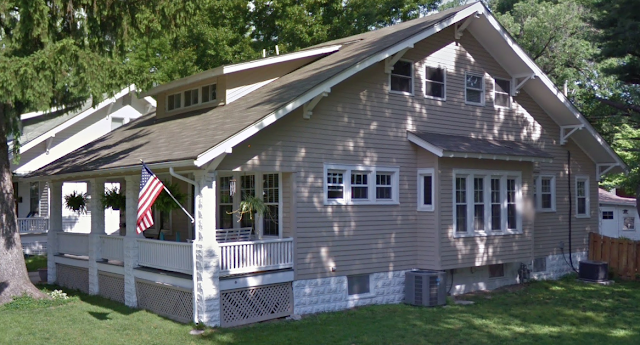 |
| Sears Hazelton • circa 1920 • 409 Franklin Avenue, Edwardsville, Illinois |
 |
| Sears Hazelton in my 1920 catalog (Click to enlarge) |
Oh, my. We do love the Hazelton.
This Hazelton in Edwardsville, Illinois (a nice college town, not far from St. Louis, Missouri) was recently for sale -- it sold in October of 2017. It's one that we knew of, because the owners had previously spoken with another researcher, and you can see an old photo of the house (when it was still white), in one of her blog posts about the Hazelton . Because it was for sale, I ran across the listing recently and was excited to finally see some interior photos! So, without further ado, let me get busy showing them to you.
The Hazelton was offered by Sears very early on, and had a good run -- beginning in 1911, and continuing through 1923. Nonetheless, when we run across a house that looks like the Sears Hazelton, we are always a little hesitant to say for certain that it is one. That's because there were other companies that offered very similar models. From this view, the thing we want to be sure and see, is the existence of the little windows in that bump out for the dining room-- because the other companies didn't have that in their DR bump out. Sometimes, though, we've found an authenticated Sears Hazelton that did not have the little side windows in the bump out ... that is very frustrating, because it throws off our analysis of this model.
Here's an example of an authenticated Hazelton in Dallas, Texas (our first house in Dallas!), that does not show little windows in the bump out... but, the owner also sent me a photo showing that they were originally there. A fire had done damage to the house, and during renovations after that, they put wood over those little windows. You can tell, in the photo, that the lighter-colored wood is over a shape that is the size of those little side windows. Who knows if you can even get little windows like that now, without paying an exorbitant price for a custom size.
 |
| Sears Hazelton on Worth Street, Dallas, Texas |
 |
| Same Sears Hazelton on Worth Street, Dallas, Texas-- you can see the side of the bump out, on this view |
 |
| Sears Hazelton on Worth Street, Dallas, Texas -- and here, we can see the newer wood, covering the original opening for the little window in the side of the bump out. |
I've done two other blog posts about the Hazelton, and shown comparisons to the versions that were offered by other companies. Here's one in Guthrie Center, Iowa, with the reverse floor plan:
 |
| It has the little windows in the sides of the bumpout! |
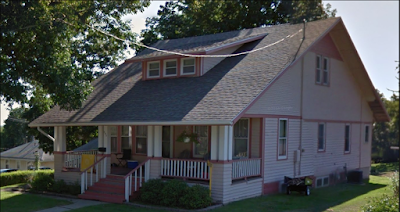 |
| And, here's the other side. You can read about this house, here. |
And here's one that I feel confident is also a Sears Hazelton, in Kirkwood, Missouri (despite the dormer roof style change:
 |
| You can read about this Kirkwood, Missouri Hazelton, here. |
In both of those blog posts, I show comparisons and images of the similar models offered by Gordon-Van Tine, Wardway, Keith's magazine, and Radford, so check them out if you're interested. Each of the posts gives some different information, so you might want to read them both.
But, let's get back to the Edwardsville Hazelton.
I've put together a set of photos that show various rooms of the house (thanks to the Zillow listing), compared next to the floor plan from the 1920 catalog. Interestingly, the Zillow listing also shows photos from a previous listing, so you can see some painting and staging differences that were made to the house for the different listings. The house has had a few changes inside, so I'll explain those as I show the photos.
First of all, here is the 1920 listing in the Sears catalog, for the Hazelton:
 |
| From my 1920 Sears Modern Homes catalog |
Here are those screen door options, shown later in the catalog-- I love the fly:
 |
| Screen doors available in the 1920 Sears Modern Homes catalog |
Inside The Hazelton In Edwardsville
The most obvious difference on the Edwardsville house, is that the kitchen has been enlarged a bit, and modernized. Originally, there was a bedroom in the back left of the house, and next to it, on the right, was a pantry, and then the kitchen. In the renovations for this house, they took over the pantry area, and also turned that bedroom into a sitting room, or eat-in area of the kitchen (depending on the set of photos you look at!), and they fit in a staircase to the upstairs. It's curious to me that the Hazelton floor plans show no access to upstairs, though we usually see that people who have the Hazelton, have used the big attic area upstairs, for extra living space--bedrooms and/or office space. So, this house has a staircase at the side of the original back bedroom, and I've seen this on another Hazelton, too. Let's take a look at the kitchen--I'll show several photos, to really give you an idea of how this is set up now. Also, by the way, notice that they cut through the wall to the dining room, to create a little pass through. Remember, you can click on any photo, to enlarge it:
There is a back porch off of the kitchen, on the Hazelton. For this house, they lost the pantry window, when they added the wall of cabinets and refrigerator, but they also added a couple of windows in the porch area, which is enclosed, and which also holds the staircase down to the basement:
 |
| We always look for this back porch, when we see a house we hope is a Sears Hazelton. |
The front of the house remains in original configuration. The front door leads you right into the living room, and has three nice big windows in the front, and then three small upper windows on the side (some Hazeltons have a fireplace there, so only have two small windows, flanking that fireplace).
Then, the living room opens up into the big dining room, with its bumped-out side, with four big, tall windows (and the two little windows in the sides of the bump out), letting in lots of light. You can see all of that in these photos. You'll also notice that this Hazelton has colonnades and cabinets separating the living room and dining room. That's not something that we always see, so those may have been added during the home's later renovation, to open up the area a bit more.
The other downstairs bedroom is in the front of the house, and has the other front set of three big windows, as well as a side window:
Upstairs, I'm not 100% sure what they have -- it may be one big master suite on one side, and another bedroom on the other side, or... well, honestly, I found it hard to follow anything more than the master suite area... especially since some photos are from a previous listing, and seem to show different uses of space. Let's start, though, with the master suite, where they have, it seems, taken over the entire front half of the upper floor of the house. The bed is placed just under the three little square windows of the wide front dormer -- in some other houses, we have seen this space with a desk there, and not much of the space to the side is used for that same room. This house seems to use all of that space for the master suite... which includes a big bathroom that doesn't seem to have a door or anything separating it from the sleeping area. It certainly feels spacious, and light.
On the back half of the upper portion of the house (so, behind the master suite), there is either this nursery...
... or this bedroom. I think this is that same space, but shown differently in the two listings:
And, somewhere, at some time, is or was this (very small) blue bedroom:
The left side of the house follows what you expect to see -- three windows downstairs:
 |
| I think those two upstairs windows might be for that little blue bedroom... maybe. You'll also notice that the front porch pillars are not those that we usually see on the Hazelton. These look to have been created out of concrete, probably using one of the Sears concrete-forming machines (you can take a look, here). |
And, this view of the right side, shows you where everything is:
 |
| 409 Franklin Avenue, Edwardsville, Illinois, in the Leclaire neighborhood |
The Fascinating History Of The Leclaire Neighborhood
Our Hazelton sits in a neighborhood of Edwardsville that was first established, in 1890, as its own little village--with an amazing story. Leclaire neighborhood wasn't incorporated into Edwardsville proper, until 1934 (along with a few other neighborhoods, one of which has another possible Sears house). This was done, at that time, because the neighborhoods had grown, were becoming a bit overcrowded, and sewage disposal was becoming a big problem. So, the son-in-law of the man who had originally established the village, who was by then the man in charge, suggested the annexation of Leclaire, into Edwardsville, and that's what was done.
But, the really fascinating back story, here, is the whole development of this Leclaire community, to begin with. It was the brainchild of N. O. Nelson, who sought to establish a community where his factory workers could live in a peaceful, pleasant setting, with education for their children, and home-ownership available, at an affordable cost. Nelson is described as, "an industrialist with a finely-tuned conscience". Here is a snippet of information on him, from the website where I learned about him:
The website with all of this information, is put together by the Friends Of Leclaire group. That link takes you to the full page with information on Nelson and his community. It's a fast read, and very interesting. Here's the start of what it explains about home ownership in the village:
Our Hazelton sits in a neighborhood of Edwardsville that was first established, in 1890, as its own little village--with an amazing story. Leclaire neighborhood wasn't incorporated into Edwardsville proper, until 1934 (along with a few other neighborhoods, one of which has another possible Sears house). This was done, at that time, because the neighborhoods had grown, were becoming a bit overcrowded, and sewage disposal was becoming a big problem. So, the son-in-law of the man who had originally established the village, who was by then the man in charge, suggested the annexation of Leclaire, into Edwardsville, and that's what was done.
 |
| Neighborhood banners in the Leclaire neighborhood. This one is across the street from a Sears Whitehall, in fact! |
 |
| Fascinating history... this is only the beginning of the story. Please go here to read the rest. |
 |
| (source) |
It goes on to explain about the first homes that were designed for this area -- remember, this was in the early 1890s, so it was well before our Sears houses were built (Sears house plans, sold along with the building supplies needed to construct them, weren't available as a package deal until 1908). However, Sears was in the building-supplies-only (no house plans) business beginning in 1895, so it is possible that some of these homes may have been built from lumber bought from Sears... but, not if the homes were built before 1895.
Our Sears Hazelton on Franklin Avenue, was built in the years when Leclaire village was beginning to suffer financially. In 1911, Nelson had moved to New Orleans to address the needs of those living in slums there, by opening a food cooperative, and investing in retail grocery stores, and the like. The cooperative worked well until WWI, and it failed, financially, in 1918, plunging Nelson into bankruptcy. He had helped deal with these financial struggles, through checks written on his N. O. Nelson company, and this whole ball of wax began to melt down.
Nelson died in 1921, and our Hazelton was probably built right around that time, so it was not part of the original dream of the Leclaire village. Nonetheless, the community as a neighborhood of lovely, simple homes, owned and cared for by residents of modest means, was still in full swing. The newer homes, however, were on smaller lots than what Nelson had originally planned, and set closer to the street, and with streets on a grid pattern, rather than the "curvilinear street system" that he had begun with. More from the website:
Today, the lovely Leclaire Lake Park remains -- it sits just behind the Franklin Avenue Hazelton:
The park contributes to the peaceful vibe of this lovely old neighborhood. It may not have the lot sizes and all of the curvilinear streets that Nelson originally called for, but it's a neighborhood style that many homeowners today crave, I think.
Who Lived Here?
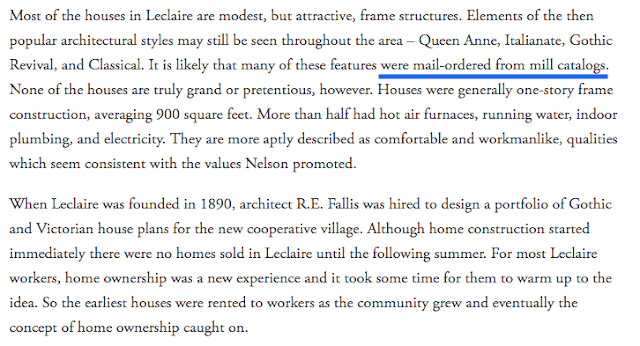 |
| (source) |
 |
| (source) |
 |
| (source) |
Today, the lovely Leclaire Lake Park remains -- it sits just behind the Franklin Avenue Hazelton:
The park contributes to the peaceful vibe of this lovely old neighborhood. It may not have the lot sizes and all of the curvilinear streets that Nelson originally called for, but it's a neighborhood style that many homeowners today crave, I think.
 |
| The view of Leclaire Lake Park, from Madison Avenue, in Edwardsville. |
 |
| Beautifully designed park sign, fabricated and installed by Dave Thomas Design, an Edwardsville company owned by our friend Dave Thomas, an Edwardsville resident. |
Using Newspapers.com, and then verifying with Ancestry.com, I came up with a few different residents over the years, but the earliest seem to be Edward and Anna Burk. I found them listed for this house in 1925, and 1929, in the Edwardsville City Directory. Madison County's real estate assessor lists this house as being built in 1920-- sometimes we find those dates to be erroneous, or to be linked more likely to when the lot was bought, but, if it is correct, then Edward and Anna are probably the first residents. They are shown living elsewhere in the 1920 census, so they may not have had the house ready in time to be living there when the census was done. Edward worked as a machine mechanic for U.S. Radiator Corp, an Edwardsville plant that employed many people in Edwardsville.
I found a fun little snippet in a 1919 edition of the Edwardsville Intelligencer, saying that Anna Burk had bought a new car: an Auburn Beauty-Six, made by the Auburn Automobile Company of Auburn, Indiana.
 |
| From the June 30, 1919 edition of the Edwardsville Intelligencer, page 4 |
 |
| Source (also shows many years of ads for this car, and images of the car) |
 |
| Radiator emblem for the Auburn Beauty-Six (source) |
It's a great looking car! Here are a few photos that I found of one, online:
Nice automobile, eh?
The Burks were no longer listed at this address in the 1930 census, so perhaps they had driven off into the sunset in Anna's Beauty-Six, and headed to another fine house to live.

















